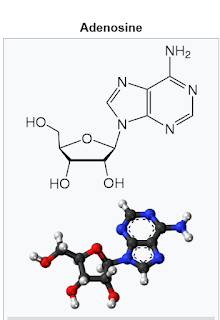Hoorah! My 30 days without coffee is done. I took a picture at bedtime two
days ago and compared to one from February. I am more tired and ready to sleep
but also have a cleaner complexion. Who knew!!
* * *
Here it is, in 3D.
Carbon in grey; Hydrogen in white; Nitrogen in blue; Oxygen in red.
It is of the purine family, and is cyclic and aromatic ie stablizing...
This week's Codemy Platform6 code wraps the player around.If Player goes off
on the left, he re-appears on the right. And vice versa. Player goes off on the right,
he re-appears on the left. Simple if clause.
More ingenious, if Player falls into the water, he re-appears in his initial position
at the top of the screen. To do this, we create a start_position.x, and a start_position.y
as variable names for the initial x,y. Then if player falls in the water, he is sent back
to his initial position.
import pygame
import self as self
#Define a 2d vector
vector = pygame.math.Vector2
#Initialize the game
pygame.init()
# Set display surface (divisible by 32 tile size)
WINDOW_WIDTH = 960 # 30 columns
WINDOW_HEIGHT = 640 # 20 rows
display_surface = pygame.display.set_mode((WINDOW_WIDTH,WINDOW_HEIGHT))
pygame.display.set_caption("Aspen Platformer - Codemy.com")
# Set FPS and clock
FPS = 60
clock = pygame.time.Clock()
# Tile Class
class Tile(pygame.sprite.Sprite):
# Read and Create tiles and put em on the screen
def __init__(self, x, y, image_integer, main_group, sub_group=""):
super().__init__()
# Load image and add to the tile subgroups
if image_integer == 1:
self.image = pygame.image.load('images/Brown.png')
elif image_integer == 2:
self.image = pygame.image.load('images/Green.png')
sub_group.add(self)
elif image_integer == 3:
self.image = pygame.image.load('images/Blue.png')
sub_group.add(self)
# add every tile to main tile group
main_group.add(self)
# Get rect of images and position within the grid
self.rect = self.image.get_rect()
self.rect.topleft = (x,y)
# Apsen Player Class
class Aspen(pygame.sprite.Sprite):
def __init__(self, x, y, grass_tiles, water_tiles):
super().__init__()
# Define our aspen image
self.image = pygame.image.load("images/P.png")
# Get rect
self.rect = self.image.get_rect()
# Position aspen
self.rect.bottomleft = (x,y)
# Reset Player if he falls in the Water
self.start_x = x
self.start_y = y
#Define our grass and water
self.grass_tiles = grass_tiles
self.water_tiles = water_tiles
# Kinematic Vectors (x,y)
self.position = vector(x,y)
self.velocity = vector(0,0)
self.acceleration = vector(0,0)
# Kinematic Constants
self.HORIZONTAL_ACCELERATION = 2
self.HORIZONTAL_FRICTION = 0.20
self.VERTICAL_ACCELERATION = 0.5 #Gravity
self.VERTICAL_JUMP_SPEED = 15
def jump(self):
# Only when player is on grass
if pygame.sprite.spritecollide(self, self.grass_tiles, False):
self.velocity.y = -1 * self.VERTICAL_JUMP_SPEED # jumping upwards thus negative
def update(self):
# set initial acceleration to 0,0 to start
self.acceleration = vector(0, self.VERTICAL_ACCELERATION)
keys = pygame.key.get_pressed()
if keys[pygame.K_LEFT]:
self.acceleration.x = -1 * self.HORIZONTAL_ACCELERATION
if keys[pygame.K_RIGHT]:
self.acceleration.x = self.HORIZONTAL_ACCELERATION
# Calculate new Kinematics
self.acceleration.x -= self.velocity.x * self.HORIZONTAL_FRICTION
self.velocity += self.acceleration
self.position += self.velocity + 0.5 * self.acceleration
# Set up wraparound
if self.position.x <0: #x value of position on left side of screen
self.position.x = WINDOW_WIDTH
if self.position.x > WINDOW_WIDTH: # Right side of the screen
self.position.x = 0
# update rect
self.rect.bottomleft = self.position
# Check for collisions with Grass
touched_platforms = pygame.sprite.spritecollide(self, self.grass_tiles, False) # Return a python list of tiles we touched
if touched_platforms:
self.position.y = touched_platforms[0].rect.top + 1
self.velocity.y = 0
# Check for collisions with Water
if pygame.sprite.spritecollide(self, self.water_tiles, False):
# print("You Died!")
# Reset Player to the top of the screen - starting position
self.position = vector(self.start_x, self.start_y)
# Reset Velocity
self.velocity = vector(0,0)
# Define our sprite groups
main_tile_group = pygame.sprite.Group()
grass_tile_group = pygame.sprite.Group()
water_tile_group = pygame.sprite.Group()
aspen_group = pygame.sprite.Group()
# Create a tile map, nested python list: 0=no tile, 1=dirt, 2=grass, 3=water, 4=aspen
tile_map = [
[0,0,0,0,0,0,0,0,0,0,0,0,0,0,0,0,0,0,0,0,0,0,0,0,0,0,0,0,0,0],
[0,0,0,0,4,0,0,0,0,0,0,0,0,0,0,0,0,0,0,0,0,0,0,0,0,0,0,0,0,0],
[2,2,2,2,2,2,2,2,0,0,0,0,0,0,0,0,0,0,0,0,0,0,0,0,0,0,2,2,2,2],
[1,1,1,1,1,1,1,1,0,0,0,0,0,0,0,0,0,0,0,0,0,0,0,0,0,0,1,1,1,1],
[0,0,0,0,0,0,0,0,0,0,0,0,0,0,0,0,0,0,0,0,0,0,0,0,0,0,0,0,0,0],
[0,0,0,0,0,0,0,0,0,0,0,0,0,0,0,0,0,0,0,0,0,0,0,0,0,0,0,0,0,0],
[0,0,0,0,0,0,0,0,0,0,0,0,0,0,0,0,0,0,0,2,2,2,2,0,0,0,0,0,0,0],
[0,0,0,0,0,0,0,0,0,0,0,0,0,0,0,0,0,0,0,1,1,1,1,0,0,0,0,0,0,0],
[0,0,0,0,0,0,0,0,0,0,0,0,0,0,0,0,0,0,0,0,0,0,0,0,0,0,0,0,0,0],
[0,0,0,0,0,0,0,0,0,0,0,0,0,0,0,0,0,0,0,0,0,0,0,0,0,0,0,0,0,0],
[0,0,0,0,0,0,0,0,0,0,2,2,2,2,0,0,0,0,0,0,0,0,0,0,0,0,0,0,0,0],
[0,0,0,0,0,0,0,0,0,0,1,1,1,1,0,0,0,0,0,0,0,0,0,0,0,0,0,0,0,0],
[2,2,2,2,0,0,0,0,0,0,0,0,0,0,0,0,0,0,0,0,0,0,0,0,0,0,0,0,2,2],
[1,1,1,1,0,0,0,0,0,0,0,0,0,0,0,0,0,0,0,0,0,0,0,0,0,0,0,0,1,1],
[0,0,0,0,0,0,0,0,0,0,0,0,0,0,0,0,0,0,0,0,0,0,0,0,0,0,0,0,0,0],
[0,0,0,0,0,0,0,0,0,0,0,0,0,0,0,0,0,0,0,0,0,0,0,0,0,0,0,0,0,0],
[0,0,0,0,0,0,0,0,0,0,0,0,0,0,0,0,0,0,0,0,0,0,0,0,0,0,0,0,0,0],
[2,2,2,2,2,2,2,2,2,2,2,2,2,2,2,2,2,2,2,0,0,0,0,0,0,2,2,2,2,2],
[1,1,1,1,1,1,1,1,1,1,1,1,1,1,1,1,1,1,1,3,3,3,3,3,3,1,1,1,1,1],
[1,1,1,1,1,1,1,1,1,1,1,1,1,1,1,1,1,1,1,3,3,3,3,3,3,1,1,1,1,1]
]
# Create Tile objects from the tile map
# 2 for loops because tile map is nested. 20 i down
for i in range(len(tile_map)):
# loop through the 30 elements in each list, j across
for j in range(len(tile_map[i])):
# Check for 0,1,2,3
if tile_map[i][j] == 1:
# dirt
Tile(j*32, i*32, 1, main_tile_group)
elif tile_map[i][j] == 2:
# grass
Tile(j*32, i*32, 2, main_tile_group, grass_tile_group)
elif tile_map[i][j] == 3:
# water
Tile(j*32, i*32, 3, main_tile_group, water_tile_group)
elif tile_map[i][j] == 4:
aspen = Aspen(j*32, i*32 + 32, grass_tile_group, water_tile_group)
aspen_group.add(aspen)
# Add a background
bg_image = pygame.image.load('images/bg.png')
bg_image_rect = bg_image.get_rect()
bg_image_rect.topleft = (0,0)
# Game Loop
running = True
while running:
# Check to quit
for event in pygame.event.get():
if event.type == pygame.QUIT:
running = False
# Jump
if event.type == pygame.KEYDOWN:
if event.key == pygame.K_SPACE:
aspen.jump()
# fill the display or blit an image
# display_surface.fill("black")
display_surface.blit(bg_image, bg_image_rect)
# Draw the Tiles
main_tile_group.draw(display_surface)
# Update and draw sprites
aspen_group.update()
aspen_group.draw(display_surface)
# Update Display
pygame.display.update()
clock.tick(FPS)
# End the game
pygame.quit()






No comments:
Post a Comment